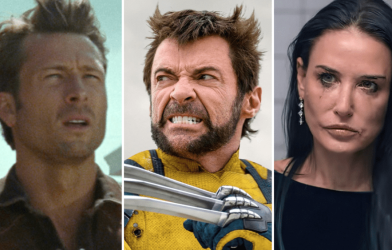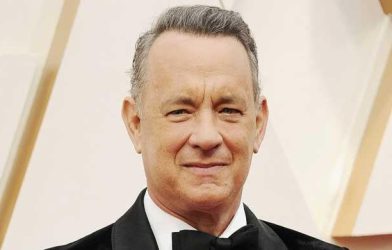
Oleh Sentsov’s Ukraine war doc ‘Real.’
Courtesy of Karlovy Vary International FIlm Festival
20 Days in Mariupol, Mstyslav Chernov’s harrowing and Oscar-winning documentary about the siege of the Ukrainian port city in the first days of Russia‘s full-scale invasion, brought home the devastation wrought by war on a civilian population. A new documentary, Real, premiering at the Karlovy Vary international Film Festival, shows the reality of the Ukraine war from the soldier’s perspective.
Real begins without explanation or warning. We are suddenly in a foxhole, hearing the frantic voice of a soldier over the radio in another trench, under attack from Russian forces and in desperate need of reinforcements. The voice on our end — that of Real director Oleh Sentsov, call sign “Grunt” — is trying to organize the evacuation of troops under fire and the resupply of his unit. Ammunition is running out, and the Russian forces — uniformly referred to over the radio as “f**kers” — are closing in.
The entire film plays out in a single, unedited cut, an hour and a half long, as Sentsov repeatedly calls between the units and headquarters and speaks to his men gathered around him, trying to cut through the fog of war and get help to the soldiers before it’s too late. We see everything through Sentsov’s eyes, via a GoPro camera attached to his helmet.
Sentsov enlisted in the Ukrainian Defense Forces shortly after Russia’s full-scale invasion in February 2022. The award-winning director of Gamer (2011), Numbers (2020) and Rhino (2021) had been using his camera to fight Russia for almost a decade. Sentsov was arrested by Russian forces in Crimea in 2014 for protesting Moscow’s annexation of the region and sentenced to 20 years imprisonment on charges of plotting terrorism. He spent five years in a Russian prison before a coordinated effort by the European Film Academy, Amnesty International and the European Parliament, with the help of directors like Ken Loach, Pedro Almodóvar and Agnieszka Holland, finally got him released, on Sept. 7, 2019, as part of a Ukrainian-Russian prisoner swap.
The events in Real, took place in the summer of 2023 as Sentsov’s unit was taking part in the Ukrainian counter-offensive, intended to break through the Russian front line and drive forces east, and out of the country. It failed.
The film’s title comes from the operation’s codename. The movie was produced by Arthouse Traffic and Cry Cinema in Ukraine together with coproducers Propeler Film in Croatia and Downey Ink in the U.K., with Sentsov, Denis Ivanov, Mike Downey, Boris T. Matić, and Lana Matić producing.
On leave from the front, Sentsov spoke to The Hollywood Reporter about the un-heroic reality of the trenches, the problems with the war “that we are not discussing inside Ukraine” and why he thinks victory is many, many years off.
When you first went to the front more than two years ago, what were your expectations going to fight for your country?
There’s a profound difference between thinking about war and going to the frontline. It’s completely different when you are on the front line and enemies are coming towards you. Basically, the front line, the Russian forces, were right across from my building where I live. When the Russians were driven out of Kyiv, and the front line was pushed back, I went east and south to try and push them out of Ukraine. But I didn’t have any good expectations, because there is nothing good about war. Nothing good at all.
Your film, Real, gives a snapshot, in real-time, of a military operation, a Ukrainian offensive that goes badly wrong. What happened that day before the action we see on screen?
This is one of those very long days. It was part of the much anticipated Ukrainian counter-offensive of last summer. We had spent almost 10 days trying to get through the Russian defense line. We lost equipment, we lost weapons. But we were still in the same place. It was really obvious that we were losing many people, losing armaments, vehicles, everything. But even at that moment, we’d kept our belief that we could do something. Our commander sent us in, two kilometers deep, to get through the Russian line. I cannot call this operation successful but I cannot say if what we were asked to do was right or not. We’re just soldiers and we were doing what we were told to do.
As a commander, I was the first one to get my people into this trench, kilometers behind the line. I moved back to bring in more people and more help. But on our way back, our BMP (armored personnel carrier) got hit by Russian fire and we got stuck in position. All our attacks from the flanks were unsuccessful so our people were cut off, from any logistics, from any connection, and from any supply. You have to understand: They were almost entirely surrounded by enemies, and I was the only one who had a connection with them and could report back up to the higher commanders. The people in the trenches didn’t have a direct connection with headquarters but I was stationed a bit uphill and could communicate with both headquarters and the people in the trench.
What you see in the movie goes from approximately 9/9:30 a.m. [for 1 and a half hours]. But that fight started at 4 a.m., and it finished at around 8 p.m.
Why were you recording, why did you want to show this?
Well, I didn’t want to make this movie. I always keep this GoPro camera on my helmet, but I’m always busy with other stuff on the front line, so I’m not recording. That day it was very chaotic and basically what I did was I was fixing my helmet and just touched the camera to see if it was still there, and I accidentally turned it on. I didn’t realize it was recording. It was six months later, I was looking through the memory card and I saw this big file and I opened it. At first, I thought it looked very random, I didn’t think it would be interesting for anyone and I wanted to erase it. But then I started to watch it and I recognized that, oh my god, this is part of this very tragic event, with so many people in the trenches, cut off and surrounded by Russians. Our friends, my friends. People who will watch the movie may never see those soldiers and these situations but they can learn how tragic it was. They can see one of the most tragic days of the Ukrainian counter-offensive
This is why I don’t call this a film or even a documentary but rather a pure document. This is the video document that shows a part of the war, a very small glimpse of the war. But this war document captured on camera really shows us how cruel, how stupid, and, I can’t even find the words to describe it, how senseless war is.

Oleh Sentsov
Photo by Laurent Van der Stockt for Le Monde/Getty Images
Who do you think people should see this document?
I hope this movie will be interesting for everyone interested in the Ukrainian war. You get a very different perception of war if you only know it from war movies or from documentaries edited to make war look presentable. There’s always this component of heroism, everyone wants to emphasize this, to show dynamic, heroic action. But real war is very, very different. My idea and my goal were to show the real war, the real people right in front of me at this moment in time. I call it an immersive experience: you are thrown in and you only slowly start to understand what’s going on. It really drags you into the trenches and helps you to feel what it’s like to be there.
When I was young, I remember watching the movie Platoon by Oliver Stone, and there’s a scene when one of the soldiers says: “Forget the word hero. There’s nothing heroic in war.” I couldn’t really understand that at the time because I grew up on very different movies that gave a very different perception of war. Now, after two and a half years in an active war zone, I have to say I completely agree with that young man in the movie and with Oliver Stone, who a long time ago was trying to show that there are no heroes in war. There is just war. The word hero is usually related to some stupid unnecessary actions that can cause terrible damage. As soldiers, we are just trying to do our work in the best possible way to protect lives and bring victory.
From the outside, it is difficult to understand what is happening on the ground. We have seen efforts to increase support for Ukraine, like the G7 promising $50 billion in new aid, or Ukrainian President Volodymyr Zelenskyy enacting the new mobilization act to bring in more troops. In your opinion, what is needed to bring an end to this war?
I think we’d probably need another hour or two just to discuss these issues. I’ll be frank. There are many things about the situation, about the reality of the war, that we are not discussing here inside Ukraine. I think this is very problematic and, being honest, I think this war is going to last many more years.
At the beginning of the full-scale invasion, many people thought the war would be over in two or three weeks. I gave an interview at the time where I said it was going to take at least two to three years, and everyone got mad at me. If you look at the situation now, we are two and a half years into this full-scale war, and we do not see the end of it. If someone would ask me how long it will take to reestablish control over the 1991 borders and to achieve a military defeat of Russia, I would say maybe it could happen in 10 years, but that would be a miracle.
Not the brightest prognosis.
We have to stare at the eyes of the truth, however painful. Otherwise, we are going to spend all our lives in an illusion that doesn’t relate to reality, to the real situation in front of us.
Interview translated from the Ukranian.
You can check out the trailer for Real below.










